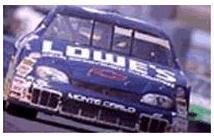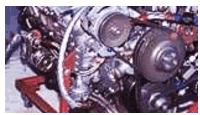|
|
|
|
|
|
|
|
|
|
|
|
|
|
|
|
|
|
|
|
 |
|
|
|
 |
Imagine you're a pit-crew member for a NASCAR Winston Cup Series team. Your team's driver is making his way through the field, but he needs to pull into pit road for service. Now it's time to jump into action -- change four tires, refuel and make minor adjustments. And all that work must take place in about 20 seconds. Spending too much time in the pits can cost a team very valuable track position. So, with that pressure in place, pit crews do whatever they can to accomplish their job quickly.
An "over the wall" pit crew consists of the gas-can man, the catch-can man, the rear-tire carrier, the rear-tire changer, the jack man, the front-tire changer and the front-tire carrier. Each member, with headset on and equipment in hand, finds his spot on the wall, which separates them from pit road, and gets ready to rumble. Not only do pit crews have the pressure of servicing their cars quickly, they have to worry about NASCAR officials looking over their shoulders, making sure they're following all the rules -- with only 20 seconds to comply. |
|
|
|
|
 |
|
|
 |
Handling does come into effect during the race at Daytona. Talladega is not a handling race track -- you don't have to handle that good -- but at Daytona you've got to handle. If you've got to fade out of the throttle a little bit going into the turn because the car is skating a little bit up the race track or it's a little loose going in it takes you a half a lap or three-quarters of a lap to get wound back up again. You've got to handle here. If you can run on the bottom of the track, or just like Earnhardt, he can turn down right in the middle of the turn to the bottom of the race track. Earnhardt handles and that's how he beats a lot of them. The cars that will handle here will run up front. To adjust your car at Daytona you kind of go by what the driver tells you and what the watches tell you. And you judge a lot by your tire temperatures. If you're in the draft and you're moving around, which it will a little and you have to tighten it up to make it stable and it slows you down you're gonna be hanging on all day. If your car's stable and you can run wide open and it's still fast you're gonna be in good shape. Some cars will run better around other cars than they will with different cars so it's who you get hooked up with and who your car runs good with that is a big factor in the race. You've got to make it fast and comfortable for the driver and sometimes you can't hit it all the time. A lot of the times you just keep working at it and working at it until you get it livable. Most of the teams will be changing right up until the qualifying races. After the qualifying races, that will give you a good test to see where your car's at for 50 laps and a pit stop. You'll see a lot of springs and shocks being changed after the qualifying races and you'll see the cars that are and aren't good. |
|
|
|
 |
|
|
|
 |
|
|
|
 |
|
|
|
Of all the elements that go into your race car at Daytona, the motor is probably the most critical. But you can?t forget it?s a package that has to come together perfectly to do well here or anywhere else. The motor has got a lot to do with it but you really have to have the complete package. You can have the best motor but if you don?t have the aerodynamics -- less drag -- in the car, you?ll be lost. Winston Cup teams go through hours and hours of work to get low drag in the transmissions, the brakes -- keeping the pads back from the rotors so there?s no drag. When you cut it clean you should be able to coast all the way around and a good driver can tell, when he cuts the engine clean, there?s something dragging just by how much it slows down. That?s how we judge how clean our car is, by how much it slows down just rolling back to the pits. The engine is real critical to qualifying. You try to qualify with a motor in which you try to get 15 or 20 more horsepower out of than you would try to race. It ain?t gonna run many laps so it has all light components, oils, fluids -- you name it, we do it. We have special qualifying transmissions, with cut-down gears that are real light. The brakes are light. Anything we can take off any rotating weight is gonna help us. We went to Talladega and tested and then we brought the car home to get it ready to come here. We put in our qualifying motor and we had to add 20 pounds of weight to get it legal. That tells you how much lighter the stuff is in our qualifying motor. For the race, you have to go 500 miles, so you put the heavier components back in. You need bigger brakes in the race because a lot of times the driver will ride the brakes a little bit in the draft. Instead of fading out of the gas and having to get it wound back up again he?ll keep the throttle down to keep the air going into the engine at the same pace and use the brake a little bit to whoa himself behind the guy in front of him. |
|
|
|
|
 |
|
|
|
|
 |
|
|
|
|




